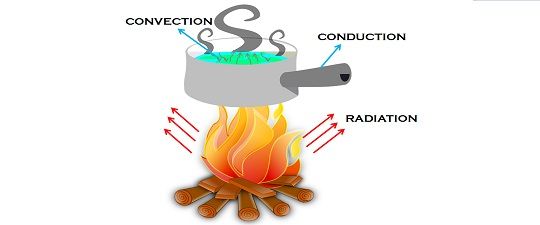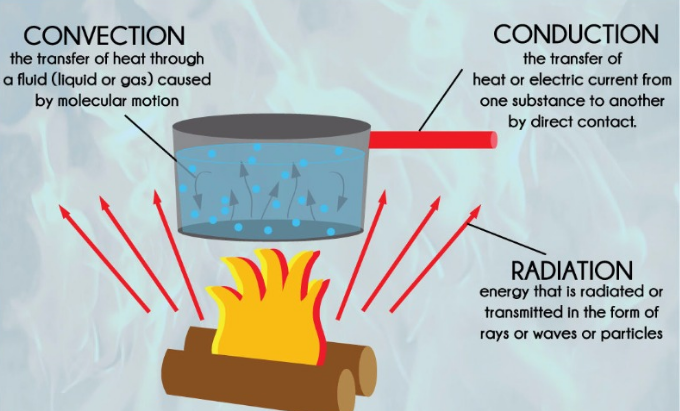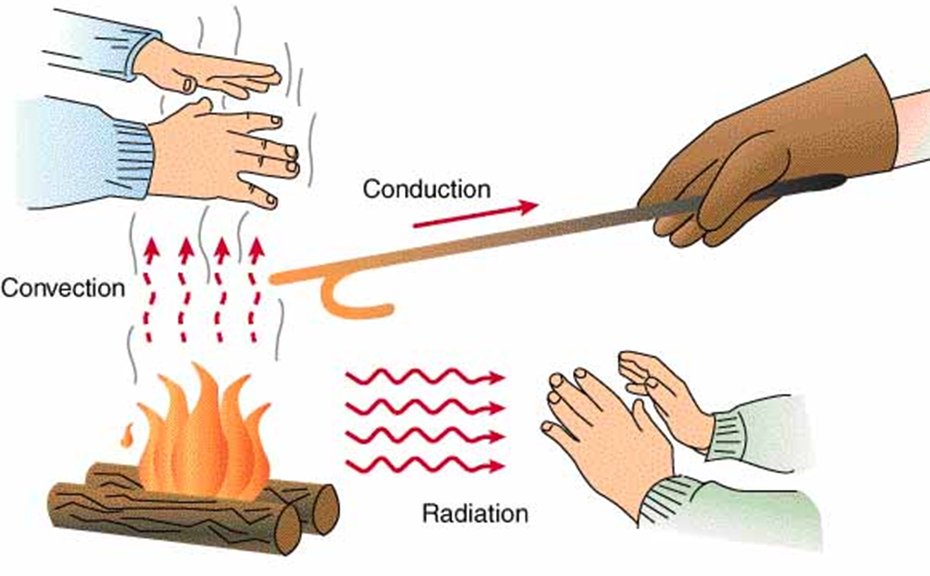How Does the Process of Convection Rely on Radiation
Convection current spreads the heat in a circular up-and-down pattern. Another way to transfer heat is by conduction which does not.

Difference Between Conduction Convection And Radiation With Comparison Chart Key Differences
How does the process of convection rely on radiation.

. Convection conduction and radiation. Radiation consists of electromagnetic waves such as Infrared and Ultraviolet energy and these have the ability to transfer in a vacuum. Radiation is the transfer of energy with the help of electromagnetic waves.
Its similar to both conduction and convection except that its contained in a vacuum. Both convection and conduction require a medium to transfer heat. The conversion of matter from one state to another is termed as a change in state that takes place.
If radiation from the sun stopped air would not be warmed and convection currents would eventually stop circulating. In radiation heat is transferred without any medium or physical conduct in the form of electromagnetic waves. In radiation heat transfer occurs through electromagnetic waves without involving particles.
This is a type electromagnetic radiation. Air current close to a radiator. Heat convection occurs when bulk flow of a fluid gas or liquid carries heat along with the flow of matter in the fluid.
You can see convection currents in a pot of water as you heat it up. Convection requires a medium. What happens with 50 of the radiation that enters the Earths atmosphere.
Convection is a form of heat transfer in which energy transition occurs within the fluid. No mass is exchanged and no. There are three basic ways in which heat is transferred.
In convection the heat transfer takes within the fluid. In gases and liquids heat is usually transferred by convection in which the motion of the gas or liquid itself carries heat from one place to another. On the other hand radiation is the process of dissipating heat via electromagnetic waves.
Radiation results in a heat flow rate that is dependent on the difference between fourth powers of temperatures of. Convection conduction and radiation. Radiation does not require a medium and can transfer heat through a vacuum.
Radiation is how heat travels through empty space. Radiation is heat transfer by electromagnetic radiation such as sunshine with no need for matter to be present in the space between bodies. Convection is how heat travels through fluids liquids and gases.
Heat is transferred from a high temperature bodyobject to a low temperature objectbody. This up-and-down motion is called a convection current. The main difference between Conduction Convection and radiation is that in conduction heat transfer through direct contact whereas in convection the movement of the molecules is involved in heat transfer.
Answer 1 of 4. The heat transfer takes place due to the difference in temperature. Convection results in a heat flow rate that is approximately directly proportional to the temperature difference.
The faster the fluid motion the greater the. Convection occurs when particles with a lot of heat energy in a liquid or gas move and take the place of particles with less heat energy. Convection Conduction Radiation There are three basic ways in which heat is transferred.
Radiation is a method of heat transfer that does not rely upon any contact between the heat source and the heated object as is the case with conduction and convection. Even in a solid like a metal. Conduction convection and radiation are the three major methods of heat transfer.
Temperature and heat are not the same thing because. Energy can be transferred by conduction convection and radiation. See answer 1 Best Answer.
Another way to transfer heat is by conduction which does not involve any motion of a substance but rather is a transfer of energy within a. The 50 is absorbed by the Earths surface. In conduction heat transfer takes place between objects by direct contact.
The air directly above the Earths surface is heated by conduction. Conduction convection and radiation. The matter is present around us in three states solid liquid and gas.
Convection in the atmosphere relies on radiation from the sun. The Convection Current is a Continuous process of warm air rising and cool air sinking creating a circular movement. This process happens in all solids when heated but is a slow process.
CONVECTION Convection is the mode of energy transfer between a solid surface and the adjacent liquid or gas that is in motion and it involves the combined effects of conduction and fluid motion. Conduction is probably the simplest to understand. Interestingly the difference in temperature is said to be a potential that causes the transfer of heat from one point to another.
But the third type radiation can transfer heat energy even in a vacuum. Conduction convection and radiation. Warm air is then circulated through the atmosphere by convection currents.
Radiation does NOT require molecules to travel. Insulation is used to stop heat energy transfers from buildings and the human body. Heat can be transmitted though empty space by thermal radiation often called infrared radiation.
Direct molecular collision is how conduction. While conduction is the transfer of heat energy by direct contact convection is the movement of heat by actual motion of matter. In gases and liquids heat is usually transferred by convection in which the motion of the gas or liquid itself carries heat from one place to another.
Radiation thermal radiation is the travel of electromagnetic waves away from a heat source. The movement of heat across the border of the system due to a difference in temperature between the system and its surroundings. Hot fluids rise up while cold fluids sink down.
Charged electrons and protons emit these heat waves that can rub off on other nearby objects like a hand over a candle. According to thermodynamic systems heat transfer is defined as. If you say that something is hot then what you are really saying is that the atoms inside of it are moving around a lot.
This is how the suns. Convection relies on radiation because radiation gets heat from the sun and then convection gets the heat from the radiation and gives the heat to earth and other planets. Up to 24 cash back Radiation.
That is they are three different ways that heat can spread.

8 Difference Between Conduction Convection And Radiation With Examples Viva Differences

What Is Conduction Convection Radiation Definition

Solar Energy Sun Ways Of Heat Transfer Conduction Convection Radiation Science Online

Comments
Post a Comment